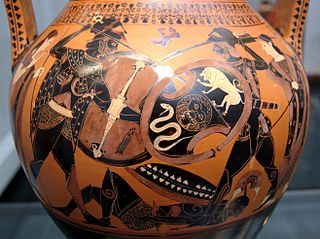
The N Painter was an Attic black-figure vase painter of the third quarter of the 6th century BC. His real name remains unknown.

The Anagyros Painter or Anagyrus Painter was a vase painter of the early Attic black-figure style, active in the first quarter of the 6th century BC. His works have only been found in inland Attica, mainly at Vari, but not in Athens itself. It is thus assumed that he was not active within the city and only produced for a very limited rural area. In contrast to many of his contemporaries, he did not paint lekanes but various large formats, such as amphorae, kantharoi, chalices, oinochoai and plates.
The Painter of the Dresden Lekanis is the common name for a vase painter of the Attic black-figure style, active around 580–570 BC. He emigrated to Boeotia and is in fact identical with the Boeotian Horse-bird Painter.
The Ptoon Painter was an ancient Greek vase painter of black-figure style active in Athens in the middle third of the 6th century BC. His real name is unknown. The Ptoon Painter predominantly painted ovoid neck amphorae, spherical '’hydriai’’, and Siana cups. His most distinguishing features are figural palmettes and striking black-and-red patterns on the wings of birds. Along with the Camtar Painter, he was one of the last painters to paint animal friezes. His work is considered of mediocre quality. He often used dotted rosettes for the backgrounds, a feature generally out of use at the time of his activity. The late date of his works is attested by certain details of his plant motifs and figures, which resemble the work of Lydos. His most famous work is the Hearst Hydria, on display in New York City.

The Castellani Painter was an Attic vase painter of the black-figure style active in the second quarter of the sixth century BC.

The Goltyr Painter was an Attic vase painter of the black-figure style. He was active in the second quarter of the sixth century BC. He is well known for his work on Tyrrhenian amphorae. He mostly painted animals, often with rather bulbous heads.

Group E was a group of Attic vase painters of the black-figure style. They were active between 560 and 540 BC.

Eye-cup is the term describing a specific cup type in ancient Greek pottery, distinguished by pairs of eyes painted on the external surface.

Hermogenes was an Attic potter. He was active in Athens in the mid-6th century BC and belongs to the group known as the Little masters. Hermogenes mainly produced cups (kylikes). Well-known are his band cups with depictions of women's heads on the band. The band skyphos, a specific type of skyphos with decoration resembling that of band cups is named after him. Hermogenes was an innovative potter. For example, similar to the potter Amasis, he made lip cups with feet derived from those of Siana cups.
The Xenokles Painter was an Attic vase painter in the black-figure style, active around the middle of the 6th century BC. His real name is unknown. His conventional name is based on the fact that he often painted vases made by the potter Xenokles, with whom he may be identical. In artistic terms, he did not reach the talent of comparable painters, such as the Tleson Painter. Characteristic of his work is his habit of cramming lip cups with figures, comparable to the normal decoration of Siana cups.
The Group of Rhodes 12264 is a Group of Attic black-figure vase painters, active in Athens around the middle of the 6th century BC. They belong to the so-called Little masters. The Group is named after the Droop cup inv. 12264 in the Archaeological Museum of Rhodes. They painted exclusively cups, mostly Droop cups with friezes in the handle zone.

The BMN Painter was an Attic vase painter in the black-figure style, active during the third quarter of the 6th century BC.

The Chiusi Painter was an Attic black-figure vase painter, active in the last quarter of the sixth century BC. His real name is not known.
The Princeton Painter was an Attic black-figure vase painter, active in the third quarter of the sixth century BC, just after Group E. His real name is not known.

The Painter of Munich 1410 was an Attic black-figure vase painter, active in the third quarter of the sixth century BC. His real name is not known. He was one of the late representatives of the black-figure style, which was in its final phase due to the introduction of red-figure vase painting. His conventional name is derived from his name vase, on display in the Staatliche Antikensammlungen at Munich. Although he is not considered an outstanding artist, some notable works are ascribed to him.

The Swing Painter was an Attic black-figure vase painter, active in the third quarter of the sixth century BC. His real name is unknown.

The Rycroft Painter was an Attic late black-figure vase painter, active in the final decade of the sixth century BC. His real name is not known.
The Hypobibazon Class was a group of Attic black-figure vase painters and a type of vase. They belong to the period around 510 BC.

The Madrid Painter was an Attic black-figure vase painter active during the late period of the style, around 520 BC.

The Edinburgh Painter was an Attic black-figure vase painter, active around 500 BC. His speciality was white-ground lekythoi painted in the black-figure style.














